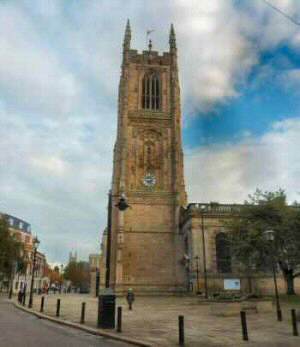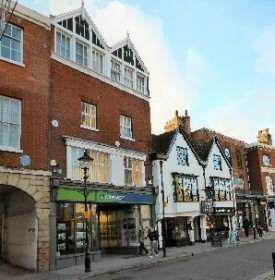CATHEDRAL QUARTER TRAILS - IRON GATE
DERBY CATHEDRAL QUARTER – 1 IRON GATE
Stylish, independent shops, great places to eat and drink, valued professional services and impressive historical landmarks. Derby’s Cathedral Quarter has it all.
Iron Gate

Iron Gate derives part of its name from the arrival of the Vikings in 874. Their language, alongside Saxon and English, would have been spoken for many generations. The suffix ‘gate’ is from the Norse word geata, which meant street in their language – street of the ironworkers. At one time the street used to be regarded as the Regent Street of Derby. And it still retains an important role in the life of the city. It was described as ‘consisting of inns and shopkeepers,’ in the 1700s and this still applies today.
In 2009, the Academy of Urbanism, whose members are top-level urban planners and architects. Short-listed Iron Gate as one of Britain’s greatest streets. Recognition by such a significant national body. Gave testament to Derby’s growing stature as an important city in the UK. As well as increasing awareness of the Cathedral Quarter as an important area with its own special identity.
Pride of place goes to All Saints Church, which became Derby Cathedral by Royal Charter in 1927. It was founded before the Norman Conquest, but no trace exists of the original church. The tower completed in 1532 is the second-highest in England. A Baroque nave was designed by James Gibbs and built by Francis Smith of Warwick in 1723-5. The magnificent wrought-iron chancel screen and gates are the work of Robert Bakewell.
Iron Gate was widened, in 1869, by the demolition of the shops and inns on the eastern side and rebuilt over twenty years. H I Stevens, George and Edwin Thompson and G H Sheffield all contributed one or more shops in a wide variety of styles. It remains one of the principal streets in Derby with a mix of quality shops, pubs, cafes and restaurants and services.
Jorrocks Public House/Foulds Music shop
The George Inn was built around 1648 and, during that era, was one of the most famous and busiest coaching inns in Derby. It had a wider frontage at that time, including the part now occupied by Foulds music shop. Following several quite recent name changes, it is now known as Jorrocks.

Charles Foulds opened his first shop in Nottingham in 1893. The shop in Iron Gate was opened in 1908. In the centenary year, the Derby shop acquired the next-door premises to open a guitar shop. This became renowned for its acoustic and jazz section and holds the UK’s largest collection of jazz guitars. Recent changes to the business have taken place
In Elizabethan days, the yard at the rear of the George was used for theatrical performances. Notoriously, it was also the venue for cockfighting. And a balconied extension was built so that patrons could watch that and other events.
A praiseworthy event took place, in 1850, when 12 carpenters meeting at the Bull’s Head were told by a traveller about the ‘Rochdale Pioneers’. They were founders of the Cooperative movement that aimed to create a society whose members would have an equal say in its running and who would benefit from its success.
As a result of the meeting, the Derby Co-operative Society was formed based on the £2 capital raised by the carpenters. Who later became known as ‘the Apostles.’ They started the society by establishing a small store in a converted hayloft in George Yard.
Joseph Wright Obelisk
Joseph Wright was the third son of John Wright, attorney and Town Clerk, and his wife Hannah Brooks. He was educated at Derby Free School in St Peter’s Churchyard. During his teenage years, he decided it was his vocation to become an artist, despite his father’s disapproval. Today Wright is held in the highest regard both locally and internationally.

There is an art gallery devoted to him at Derby Museum and Art Gallery. His paintings hang in the National Gallery in London, and the Louvre, in Paris. In 1997 an exhibition was put together with 260 of his paintings and drawings. To celebrate the 200th anniversary of his death. The marble memorial pillar opposite Wright’s birthplace in Iron Gate. Depicts an Orrery, a mechanical model of the solar system, which is featured in one of his most famous works. The building in which he was born has been demolished.
Bennetts Department Store (now closed)
In 1734, the store started life as an Ironmongers shop, under the name Weatherhead, Walters and Son. However, in 1864, George Bennett, a retired Master Mariner, bought the company and expanded the product range.

The present store is actually two buildings joined into one, which explains its somewhat unusual shape. This came about in the 1980s when number eight Iron Gate was purchased. At one time part of the building served as a theatre. Hence, the rather striking staircase and imposing balcony.
In an advertising campaign, Bennetts claimed that it was the oldest department store, not only in Derby but in the World. Today, only the name lives on.
Bennetts’s prestigious January Sales were always eagerly awaited and queues formed in the street. But they were never so long as those formed outside one of its neighbours in 1971 when Rolls Royce crashed. At that time the former Derbyshire Building Society had its Head Office in the street, and record crowds queued in the street. The purpose was to remove their savings, investors thinking the Society had invested in Rolls-Royce. This was not the case as Building Society law expressly forbade investment in companies.
The Standing Order
In 1725, on the death of his father Samuel Crompton Junior took over the family’s banking business. This provided him with sufficient capital to build the Friary, in Friar Gate. For a time he was the only financier in Derby.
The notorious Heath Brothers started money lending in 1745 and Thomas Evans in 1771. Samuel Crompton’s son, another Samuel, succeeded him in 1757, both at the Friary and in banking.
The Heath Brothers went bankrupt in 1779 and the banks of both Evans and the Crompton family continued to thrive. Eventually, both banks amalgamated and became the Crompton and Evans Union Bank. This later became the Nat West. Following a restructuring programme, the Nat West found they no longer needed the premises and they were converted into a public house rather appropriately named the Standing Order.
Iron Gate House

Samuel Crompton built Iron Gate House in the early 18th century. The ground floor was used as the family bank until 1880. When another bank, the Crompton and Evans Bank was built next door, following the acquisition of the Talbot Inn. Iron Gate House is now occupied by the Thomas Leaper public house. It is named after a former resident whose home was on the same site.
Number 24 Iron Gate

Twenty-four Iron Gate was the home from 1737, of John Whitehurst, the well-known horologer, scientist and philosopher. Born on 10 April 1713, he was the eldest son of John Whitehurst, a clockmaker from Congleton. However, when he first arrived in Derby, he was told he could not set up a shop as he was not a freeman in the town. And, it was only after he repaired the Guildhall clock for free that this condition was removed.
Whitehurst was one of the foremost scientists of his day and a founder member of the Lunar Society. He became interested in geology whilst on long walks with his father in the Peak District. However, it was as a clockmaker and engineer that he is best known. His innovations included the round dial longcase clock.
The premises later served as a photographer’s studio for Richard Keene. He was born in London on 15 May 1825 and moved to Derby with his family three years later. After learning about printing, publishing and bookselling, he occupied the premises in Iron Gate where John Whitehurst had resided. It was not long after that he developed an interest in photography, taking many scenes in Derby and Derbyshire. To provide a studio, the roof was removed and the present glass structure was substituted.
Photography dominated his business and he became known for high-quality topographical views. At the time of his death in 1894. He had won 34 major awards, taken commissions from the Royal Family and was President-Elect of the Photographic Convention of the United Kingdom. His pictures can still be seen in local history books, newspapers and magazines.
Derby Cathedral
Visible from a considerable distance, Derby Cathedral dominates the skyline with its impressive perpendicular tower. A church was built early in the 16th century, but worship has taken place on this site since the 10th century.

Light and spacious inside, the iron screen by Robert Bakewell is an inspirational masterpiece in this proud and beautiful building. The tower at 212 feet is said to be the second-highest in England, next to Boston Stump, and it has the oldest ring of ten bells in the world. Derby Engineer George Sorocold re-hung the bells in 1687, which is commemorated by a brass plaque in the chancel.
A combination of events led to it becoming Derby Cathedral, in 1927. A new diocese of Southwell had been created in 1884, and the majority of the County of Derbyshire was transferred from Lichfield to the new see. Five years later, the first assistant bishop to the diocesan Bishop of Southwell was appointed with the title Bishop of Derby. He and his
successor worked for the creation of a new diocese of Derby, and this came to fruition with the hallowing of All Saints as its Cathedral Church.
Many interesting features and monuments are housed in the cathedral, including Bess of Hardwick’s Monument, Joseph Wright’s Tombstone, the Bakewell Screen and much more. In 1978, the outer part of the Cavendish burial vault was converted into a small Crypt Chapel.
The Cathedral Church of All Saints is exceptionally beautiful inside. No charge is made to enter, although donations are always welcome. Visitors are encouraged to walk around, sit and enjoy the atmosphere, join in worship if they desire, light a candle or pray.
Derby Cathedral Centre
Opened by HM the Queen on 14 November 2003, Derby Cathedral Centre holds many of the Cathedral’s treasures. Also, it provides a place to host meetings and events. The venue combines fine architectural detail with the latest contemporary styling, new technology and comfort. When the time comes to relax there are eye-catching views to be enjoyed. The highly acclaimed cafe was a past winner of Best Tea/Coffee Shop in the Derbyshire Food and Drinks Awards. However, the cafe closed during the pandemic. and did not reopen.

